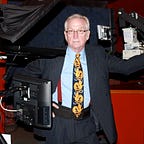The Little Colonel and the Sailor
Before Taylor Swift. Before Cher or Madonna. Before Aretha Franklin or Janis Joplin. Or Marilyn Monroe or Elizabeth Taylor. Or even Judy Garland. There was a female celebrity who eclipsed them all, and she was only six years old. Her name was Shirley Temple.
And here she is in a classic picture showing the most popular actor of the 1930’s visiting Pearl Harbor and ‘inspecting’ the ships. In this case it was the submarine, SS Pollack. The photographer was my father — Seaman 2nd class William Joseph Castengera.
He had just transferred to the Pollack a few months before, after serving aboard the submarine tender USS Holland also based in Pearl Harbor. It was to be a start of a Navy career in the most dangerous of all Navy services — submarines where more men died than any other branch of the services.
Shirley Temple had become a frequent visitor to Hawaii after becoming an international movie star only a few years before at the tender age of six. It started in 1934 when she appeared in six movies, starting with Stand Up and Cheer, but climaxed that year in the movie, Bright Eyes, in which she sang what was to be her signature piece — On the Good Ship, Lollipop.
This was only five years after the Great Depression had hit and its effects were still being felt. Nobody knew that more than President Franklin D. Roosevelt and nobody knew how important Shirley Temple was than FDR who that year declared: “As long as we have Shirley Temple, we will be okay.”
By 1935, she had become an even greater full-fledged star: “a major box office attraction.” And her first movie that year was the one that was to become her unofficial ‘military’ name — The Little Colonel. It was completely filmed in her now beloved Hawaii.
https://www.imdb.com/title/tt0024914/?ref_=ttls_li_i
Shirley Temple went on to star in four films in 1935, four films in 1936 and then what may be her most famous film, Heidi, in 1937.She starred in many films after that. By the time picture featured above was taken, she was at the height of her career. By this time she was a ‘pre-teen.’ Then she became a teenager. And as her childhood faded, so did her career.
Shirley Temple continued making pictures, but they became fewer and fewer as her public adulation diminished. Submariner Castengera stopped taking pictures or at least very few, probably because of war-time restrictions.
Then came 1941. Japan attacked Pearl Harbor on December 9th of that year — “a day that will ive in infamy.” Seaman Castengera had become Chief Petty Officer Castengera, and just two months before that attack, had again re-enlisted.
The war ended in Europe on May 2, 1945. It didn’t end in the Pacific until four months later on September 2, 1945 after the nuclear bombs were dropped on Hiroshima and Nagasaki.
Castengera had met and married an Australian woman, Eileen Marion Dixey, only two years before. With the official ending of the war, Castengera was returned to the US aboard his latest assigned submarine, leaving behind his bride — and their two children. The new Mrs. Castengera, with her two-year-old daughter and one-year-old son, came to the US aboard one of the many cruise ships pressed into service during WWII — the SS Mariposa. That was the same ship that had first brought Shirley Temple to Hawaii ten years earlier.
Shirley Temple only starred in five movies through World War II, and only seven after the war. But after the war she continued to visit her much loved Hawaii, meeting her future husband, Charles Alden Black, a former naval intelligence officer who was then an executive with the Hawaiian pineapple company. Mrs. Shirley Temple Black went on to a long career in politics, serving as U.S. ambassador to several countries.
Special Notes:
1. Judy Garland’s movie debut was, of course, in The Wizard of Oz, made in August of 1939 when she was 16 years old.
2. The date of the featured picture cannot be confirmed definitively. The estimate is based on Castengera’s service record and Temple’s movie schedule as well as her documented trips to Hawaii. That indicates either late 1939 or early 1940.
3. There are few pictures of Shirley Temple in Hawaii, but one that would appear to confirm the date of 1939 reportedly shows her at that time with Diamond Head in the background.
4. In the photos that do exist of her, she is often seen aboard submarines, possibly because Pearl Harbor was a major battle ship harbor but also a submarine harbor and they were much more accessible.
5. Celebrities and officers were usually “piped aboard” US Navy ships. However, it is not clear what the reference to .190 means.
6. Shirley Temple became a regular visitor to the White House during the war and became close friends with The First Lady, Eleanor Roosevelt.
7. Shirley Temple even wrote a book about her many trips to Honolulu.
8. It is a testament to her popularity that there was a drink named after her. By most accounts it was created in Hawaii. It is a mixture of ginger ale, grenadine, with a splash of orange and a cherry.
9. During her movie career, and most notably in the movie The Little Colonel, Shirley Temple appeared in several dance routines with Bill Robinson, a black man noted for his soft shoe and tap dancing abilities. The studios tried to dissuade her from doing this, but she insisted on dancing with him.
10. In all, Shirley Temple appeared in 35 movies, according to IMDB records.
